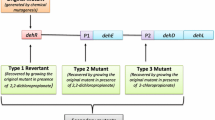Abstract
2-Hydroxychromene-2-carboxylate isomerase activity was found in cell-free systems from bacteria that degrade naphthalenesulfonates. The enzyme fromPseudomonas testosteroni A3 was activated by incubation with glutathione, dithiothreitol or mercaptoethanol. The highest enzyme activity was found after preincubation of the enzyme with glutathione at alkaline pH-values. A highly purified enzyme preparation converted besides 2-hydroxychromene-2-carboxylate also 2-hydroxybenzo[g]chromene-2-carboxylate (the 2-hydroxychromene-2-carboxylate formed from 1,2-dihydroxyanthracen). The addition of various metal ions or EDTA did not significantly change the catalytic activity of the enzyme. A possible reaction mechanism is proposed.
Similar content being viewed by others
Abbreviations
- 2,5-DHCCA:
-
2,5-dihydroxychromene-2-carboxylate
- 2,6-DHCCA:
-
2,6-dihydroxychromene-2-carboxylate
- 1,2-DHN:
-
1,2-dihydroxynaphthalene
- GSH:
-
glutathione
- 2HBCCA:
-
2-hydroxybenzo[g]chromene-2-carboxylate
- HBP:
-
2′-hydroxybenzalpyruvate
- HBPA:
-
2′-hydroxybenzalpyruvate aldolase
- 2HCCA:
-
2-hydroxychromene-2-carboxylate
- 2HCCAI:
-
2-hydroxychromene-2-carboxylate isomerase
- 2NS:
-
naphthalene-2-sulfonate
- Rt :
-
retention time
References
Barnsley EA (1976) Naphthalene metabolism by pseudomonads: the oxidation of 1,2-dihydroxynaphthalene to 2-hydroxychromene-2-carboxylic acid and the formation of 2′-hydroxybenzalpyruvate. Biochem. Biophys. Res. Comm. 72: 1116–1121
Bradford MM (1976) A rapid and sensitive method for the quantitation of protein utilizing the principle of protein dye binding. Anal. Biochem. 72: 248–254
Brilon C, Beckmann W, Hellwig M & Knackmuss H-J (1981a) Enrichment and isolation of naphthalenesulfonic acid-utilizing pseudomonads. Appl. Environ. Microbiol. 42: 39–43
Brilon C, Beckmann W & Knackmuss H-J (1981b) Catabolism of naphthalenesulfonic acids byPseudomonas sp. A3 andPseudomonas sp. C22. Appl. Environ. Microbiol. 42: 44–55
Davies JI & Evans WC (1964) Oxidative metabolism of naphthalene by soil pseudomonads. The ring-fission mechanism. Biochem. J. 91: 251–261
Dua RD & Rao V (1986) Production oftrans-o-hydroxybenzalpyruvate from 1,2-dihydroxynaphthalene by cell-free extracts ofCorynebacterium renale. Indian J. Biochem. Biophys. 23: 110–113
Eaton RW & Chapman PJ (1992) Bacterial metabolism of naphthalene: construction and use of recombinant bacteria to study ring cleavage of 1,2-dihydroxynaphthalene and subsequent reactions. J. Bacteriol. 174: 7542–7554
Evans WC, Fernley HN & Griffiths E (1965) Oxidative metabolism of phenanthrene and anthracene by soil pseudomonads. The ring-fission mechanisms. Biochem. J. 95: 819–831
Fernley HN & Evans WC (1958) Oxidative metabolism of polycyclic hydrocarbons by soil pseudomonads. Nature 182: 373–374
Kodama K, Umehara K, Shimizu K, Nakatani S, Minoda Y & Yamada K (1973) Identification of microbial products from dibenzothiophene and its proposed oxidation pathway. Agr. Biol. Chem. 37: 45–50
Kuhm AE, Schlömann M, Knackmuss H-J & Pieper DH (1990) Purification and characterization of dichloromuconate cycloisomerase fromAlcaligenes eutrophus JMP 134. Biochem. J. 266: 877–883
Kuhm AE, Stolz A, Ngai K-L & Knackmuss H-J (1991) Purification and characterization of a 1,2-dihydroxynaphthalene dioxygenase from a bacterium that degrades naphthalenesulfonates. J. Bacteriol. 173: 3795–3802
Kuhm AE, Knackmuss H-J & Stolz A (1993) Purification and properties of 2′-hydroxybenzalpyruvate aldolase from a bacterium that degrades naphthalenesulfonates. J. Biol. Chem. 268: 9484–9489
Lack L (1961) Enzymiccis-trans isomerization of maleylpyruvic acid. J. Biol. Chem 236: 2835–2840
Monticello DJ, Bakker D & Finnerty WR (1985) Plasmid-mediated degradation of dibenzothiophene byPseudomonas species. Appl. Environ. Microbiol. 49: 756–760
Nörtemann B, Baumgarten J, Rast HG & Knackmuss H-J (1986) Bacterial communities degrading amino- and hydroxynaphthalene-2-sulfonates. Appl. Environ. Microbiol. 52: 1195–1202
Palmer T (1985) Understanding enzymes. Ellis Horwood Publishers, Chichester
Patel TR & Gibson DT (1974) Purification and properties of(+)-cis-naphthalene dihydrodiol dehydrogenase ofPseudomonas putida. J. Bacteriol. 119: 879–888
Patel TR & Barnsley EA (1980) Naphthalene metabolism by pseudomonads: purification and properties of 1,2-dihydroxynaphthalene oxygenase. J. Bacteriol. 143: 668–673
Pfennig N & Lippert KD (1966) Über das Vitamin B12-Bedürfnis phototropher Schwefelbakterien. Arch. Mikrobiol. 55: 245–256
Seltzer S & Lin M (1979) Maleylacetonecis-trans-isomerase. Mechanism of the interaction of coenzyme glutathione and substrate maleylacetone in the presence and absence of enzyme. J. Am. Chem. Soc. 101: 3091–3097
Walter U, Beyer M, Klein J & Rehm H-J (1991) Degradation of pyrene byRhodococcus sp. UW1. Appl. Microbiol. Biotechnol. 34: 671–676
Yen K-M & Gunsalus IC (1982) Plasmid gene organization: naphthalene/salicylate oxidation. Proc. Natl. Acad. Sci. U.S.A. 79: 874–878
Yen K-M & Serdar CM (1988) Genetics of naphthalene catabolism in pseudomonads. CRC Crit. Rev. Microbiol. 15: 247–267
Author information
Authors and Affiliations
Rights and permissions
About this article
Cite this article
Kuhm, A.E., Knackmuss, HJ. & Stolz, A. 2-Hydroxychromene-2-carboxylate isomerase from bacteria that degrade naphthalenesulfonates. Biodegradation 4, 155–162 (1993). https://doi.org/10.1007/BF00695117
Received:
Accepted:
Issue Date:
DOI: https://doi.org/10.1007/BF00695117




